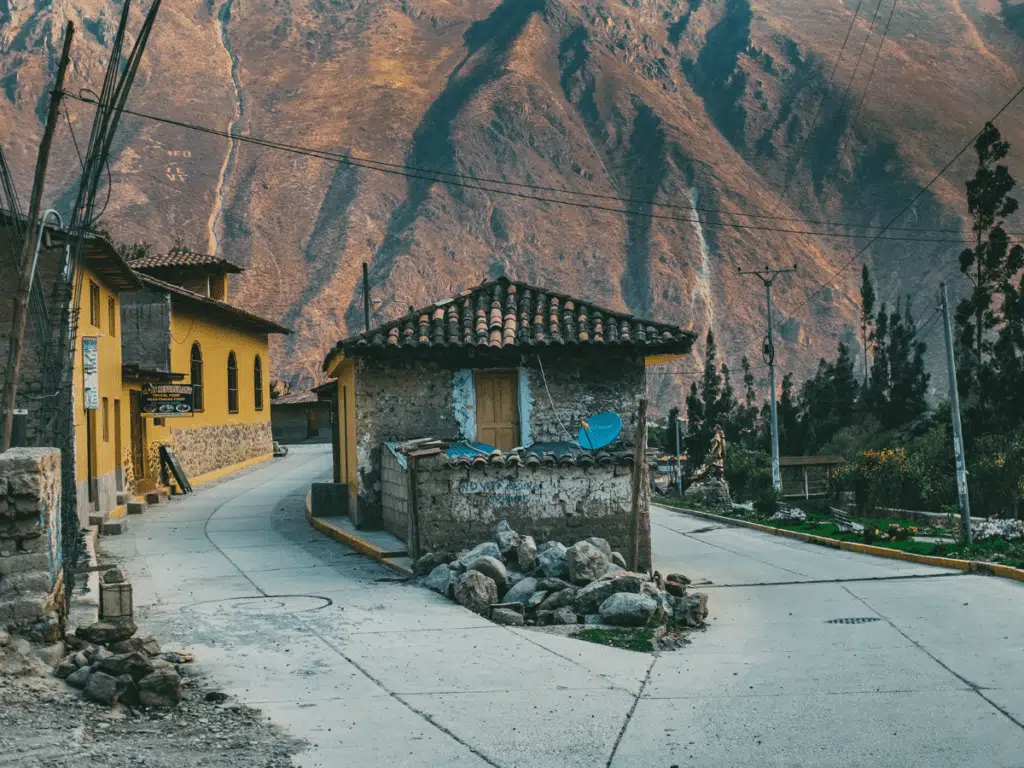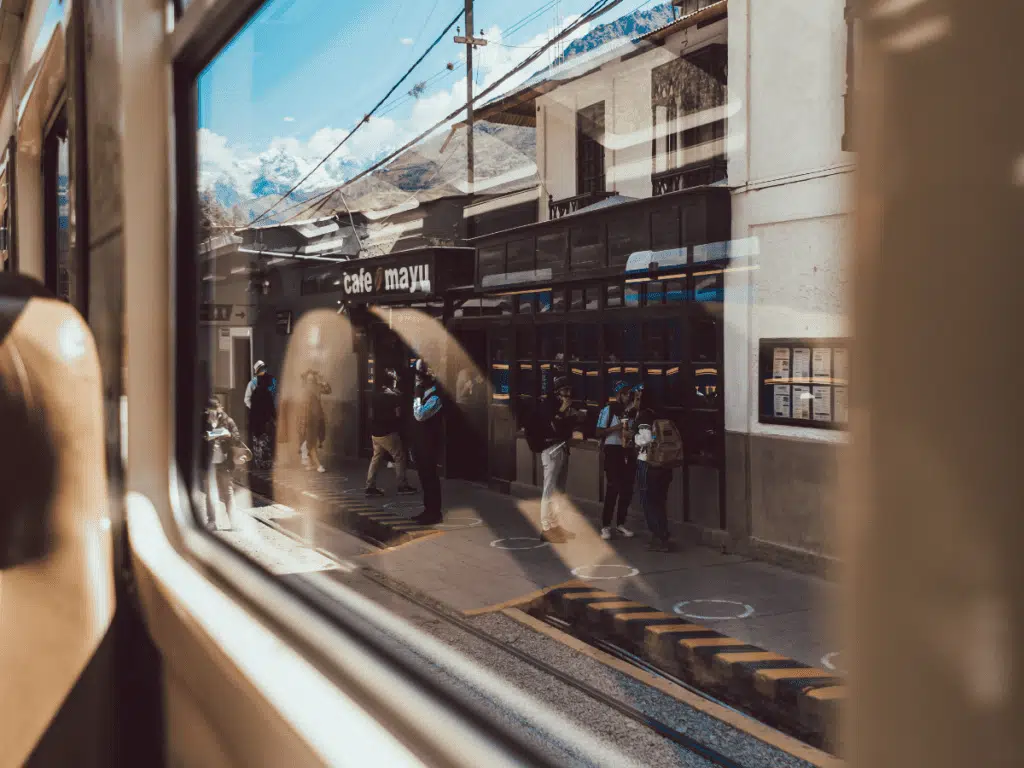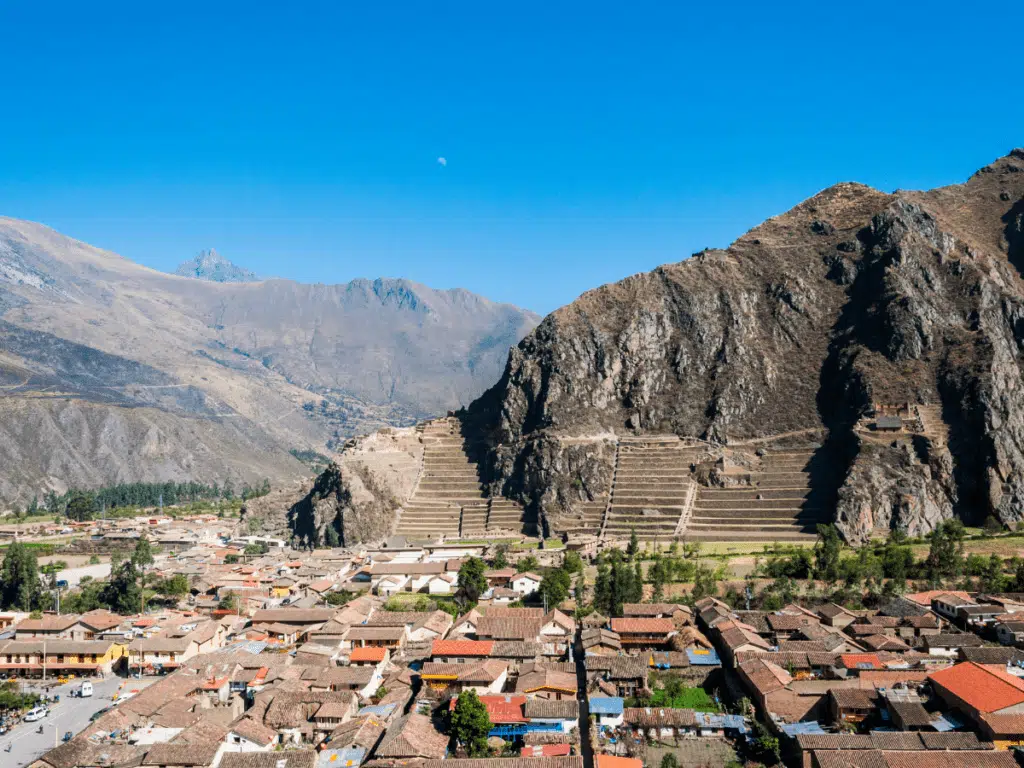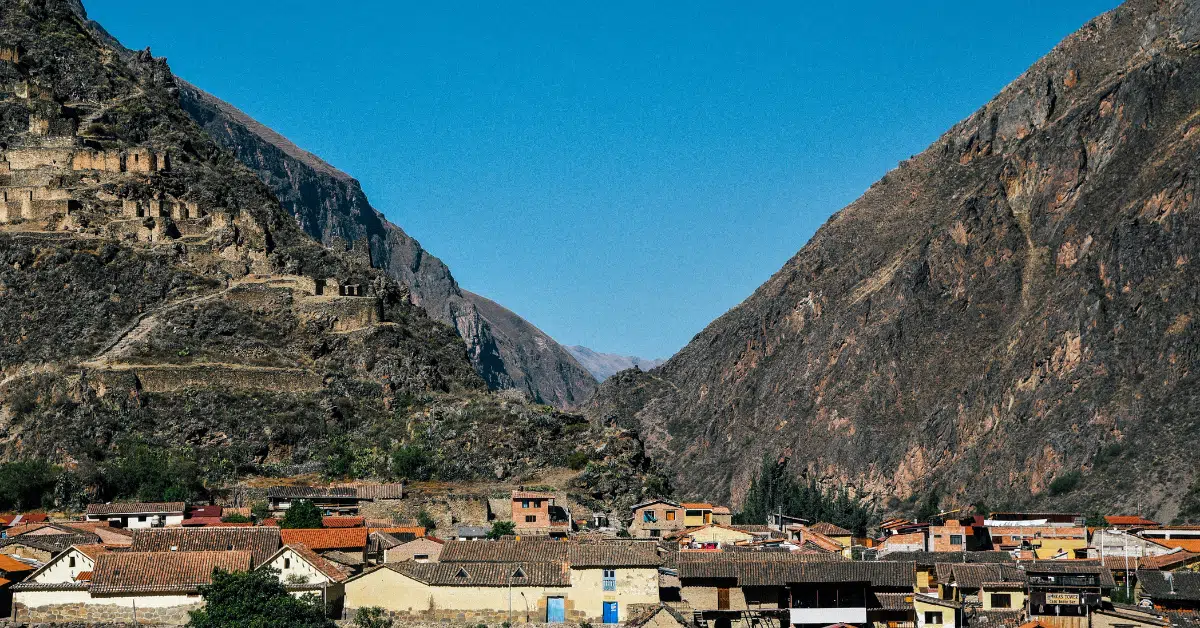Ollantaytambo, Peru: Ultimate Traveler’s Guide
Nestled in the heart of Peru’s Sacred Valley, Ollantaytambo is home to some of the most beautiful mountain scenery in Peru, and some of the most extensive and fascinating Incan ruins you’ll find anywhere. Ollantaytambo is also the most common starting point for the famed four-day Inca Trail trek to Machu Picchu, perhaps the most well-known trek in the world.
With these impressive credentials, you’d think Ollantaytambo would be a given on any Peru itinerary. However, many visitors spend just an hour or two at the Ollantaytambo Ruins, or skip it entirely on the way to Machu Picchu.
While Ollantaytambo’s proximity to Machu Picchu has its benefits, it means too many tourists overlook this gem. Don’t make the same mistake!
In this ultimate Ollantaytambo guide, we’re covering all you need to know to make the most of your time here. We’re covering everything from the altitude (and how to adjust to it!) to how to get to Ollantaytambo and, of course, the ruins.

This post contains affiliate links that may reward me monetarily or otherwise when you use them to make qualifying purchases – at no cost to you. As an Amazon Associate, I earn from qualifying purchases. For more information, please read our disclosure policy.
Ollantaytambo
Located about halfway between Machu Picchu and Cusco, Ollantaytambo sits in the heart of the Sacred Valley of Peru. Home to some of the most impressive Incan Ruins outside of Machu Picchu, Ollantaytambo is a destination well worth visiting, and one of the highlights of the Sacred Valley.
Ollantaytambo was an important Incan city in its time, and the royal estate of the Incan Emperor Patchacuti. Upon the arrival of the Spanish, it was the site of the Battle of Ollantaytambo in 1537, led by Incan resistance leader Manco Inca against the conquistador Hernando Pizarro.
When visiting the Ollantaytambo Ruins you’ll be impressed to see how much remains, and be able to learn even more about the historical significance of the site. Unlike Machu Picchu, there are extensive writings about Ollantaytambo and records that show its important history to the Incas, both prior to and after the Spanish conquest.
Today Ollantaytambo is one of the most important destinations in the Sacred Valley. The ruins at Ollantaytambo are some of the most visited in the Sacred Valley.
Many travelers pass through on their way to Machu Picchu, but Ollantaytambo – called “Ollanta” by the locals – has so much more to offer than just its proximity to Machu Picchu.
Read More: Peru’s Sacred Valley: Ultimate Travel Guide
What is Ollantaytambo Known For?
Ollantaytambo is best known for having some of the most impressive Incan ruins in Peru outside of Machu Picchu. Here you can visit the remains of the fortress at the center of the Battle of Ollantaytambo in 1537, plus temples, extensive terracing, and Incan storehouses.
The ruins are truly impressive, and allow visitors to get an up close and personal look at history.
Today, it’s also known as an important transportation hub in the Sacred Valley. The Inca Rail trains to Machu Picchu (Aguas Calientes station) start from Ollantaytambo, and there is a Peru Rail train station here as well. Keep reading for our guide to transportation to and from Ollantaytambo for more details.
Is Ollantaytambo Worth Visiting?
Ollantaytambo is definitely worth a visit! This is a charming small town with the most incredible Incan ruins, and located at the heart of one of the most beautiful and interesting areas of Peru.
You’ll find a wealth of beautiful accommodations options, delicious food, and engaging tours and activities here, so make sure to add Ollantaytambo to your itinerary.
Ollantaytambo is worth a visit in its own right, but it also makes for a fantastic base from which to explore the rest of the Sacred Valley. You can spend time here exploring the many archaeological gems in the area, while you simultaneously acclimatize to the altitude.
It’s understandable that many travelers with just a short time in Peru skip Ollantaytambo, or only visit to catch the train to Machu Picchu. No one can deny that having such a world-famous neighbor takes a bit of the shine from Ollantaytambo.
However, if you have time in your itinerary, Ollantaytambo is a fantastic addition.
Ollantaytambo Altitude
Sitting at an altitude of 9,186 feet (about 2,800 meters), the altitude at Ollantaytambo is quite high. If you’re arriving from lower altitudes, you’ll need at least one day – or even better, two – to adjust. However, if you are coming from Cusco, which sits at 11,152 feet (3,399 meters), you’re actually going down in elevation. Machu Picchu is lower still at 7,972 feet or 2,430 meters.
Many visitors to Ollantaytambo that spend a few days here use their time to acclimate to the high altitudes.
Cusco is generally the spot most travelers choose to acclimate to the altitude before heading on to Machu Picchu and the Sacred Valley, but Ollantaytambo is a great option if you want to explore the ruins and escape from the hustle and bustle of the city while you do it.
It’s also a great place to acclimate if you’re hiking the Inca Trail – the trail begins just outside the city.

Machu Picchu Packing List
Don’t prepare for your trip without reading our ultimate Machu Picchu Packing List. We’ve listed everything you’ll need for the day of, and the rest of your Peru trip.
Ollantaytambo Transportation
Ollantaytambo Train Station
Located right in the center of town, you can’t miss the Ollantaytambo train station that brings passengers throughout the Sacred Valley and on their way to Machu Picchu. Here you’ll find the platforms for the Inca Rail and Peru Rail trains, and their corresponding ticket windows and waiting areas.
While you can usually buy your tickets on-site, it’s always a good idea to purchase in advance ahead of time, especially if you’re planning on traveling during the high season.
This way, you’ll be able to ensure that you can make it to Machu Picchu with as much time as possible to enjoy the site. Peru Rail sells passes via Viator or their own website, and Inca Rail tickets are also for sale in advance online.
You can check out some of the details about each train class here:
- Peru Rail Expedition Train
- Peru Rail Vistadome Train
- Hiram Bingham Luxury Train
Ollantaytambo to Cusco
Ollantaytambo is accessible to Cusco via road and is frequented by buses and taxis, so you’ll have your choice of transportation options. The journey takes about an hour and a half.
You can often find groups of travelers that split the cost of a taxi to Ollantaytambo from Cusco, by inquiring with other travelers in your Cusco accommodation or speaking with the organizers of your Machu Picchu tour.
Even if you’re not able to share a taxi, the 1.5-hour journey usually costs only around $25-30.
Ollantaytambo to Aguas Calientes
Ollantaytambo is the “end of the road” on the journey to Machu Picchu from Cusco – from here, you’ll need to take a train to reach Aguas Calientes, the small town just below Machu Picchu. Though only about 25 miles away, the journey by train through the mountains takes about 1.5 hours.
From Ollantaytambo, you can select either the Peru Rail Trains or the Inca Rail Trains to Aguas Calientes. Each train line offers a variety of different classes for passengers, from quite basic to luxury trains like the Hiram Bingham.
I’d highly recommend choosing to travel on the Peru Rail Vistadome train – we used this train to reach Machu Picchu and had an incredible time. More than just a mode of transportation, it was a travel experience itself!
The Vistadome train cars have panoramic views through giant windows and glass ceilings, which help you take full advantage of the incredible mountain views along the winding journey.
How Long Does it Take to Get From Ollantaytambo to Machu Picchu?
To get from Ollantaytambo to Machu Picchu takes about 2 hours. First, take a train from the Ollantaytambo train station (either the Peru Rail or Inca Rail train) to Aguas Calientes – the journey lasts about 1.5 hours.
Then, take a 25-minute bus ride from Aguas Calientes straight up the winding road up the mountain to the entrance to Machu Picchu.
Machu Picchu Tickets
Order your tickets to Machu Picchu as far in advance as you can! Access is limited to preserve this historic site.
- Machu Picchu Ticket
- Machu Picchu and Huayna Picchu Ticket
- Bus Ticket from Aguas Calientes to Machu Picchu
Ollantaytambo Map
I’ve created this interactive Ollantaytambo map with pins in all the locations that I mention in this article. Feel free to click around and use this Ollantaytambo map as you read through the article and plan your trip.
You’ll also find pins dropped in other important points of reference like Aguas Calientes and Machu Picchu, as well as Cusco.
Ollantaytambo Ruins
The impressive Ruins of the fortress at Ollantaytambo are unmissable when visiting this town. They are easily some of the best and most complete Incan ruins outside of Machu Picchu that you’ll find.
If you’re looking to explore the site more completely, consider hiring a guide to lead you through the complex. You’ll learn so much more about what you’re seeing when visiting!
These are some of the highlights of the Ollantaytambo Ruins, though there are plenty more you’ll discover as you explore the site:
Terraces
There are countless terraces at Ollantaytambo! During the Battle of Ollantaytambo, indigenous defenders flooded the valley and used them as a vantage point to attack the Spanish invaders.
“Baño de la Nusta” – Bath of the Princess
This beautiful fountain at the base of the ruins was used for liturgical purposes and flows from carved stone into a pool.
Six Monoliths of the Sun Temple
Perhaps the most impressive part of the ruins, these massive, multi-ton monoliths form an important part of this most important temple at the site. You’ll marvel at the size and wonder at the ability of the artisans and laborers to move these massive stones in place.
Set aside at least two to three hours to properly explore the best of the site. Plus, if you’re interested in just wandering the ruins and getting lost among them – highly recommended, this is the best, and my personal favorite part! – set aside even more time here.
Access to the ruins is through the Cusco Tourist Pass, which grants access to up to 16 archeological sites throughout the Sacred Valley and is valid for up to ten days. Access to the Ollantaytambo Ruins is through the 2-day or 10-day ticket options. You can easily book your ticket online through Viator.
Cusco Tourist Pass
You’ll need to purchase the Cusco Tourist Pass to visit almost any of these destinations – especially the sites with ruins! The Cusco Tourist Pass is an excellent deal and includes admissions to a variety of sites in and around Cusco over a number of days. Book your Cusco Tourist Pass in advance and start planning your trip!

Ollantaytambo Town
While the Ollantaytambo Ruins are what draws most visitors here, Ollantaytambo town is a gem itself, and well worth exploring.
You can feel the history of the city as you walk down every street – many have remaining Incan stonework plus colonial Spanish influence.
The town also has a great array of restaurants, cafes, and shops to peruse, selling all kinds of handicrafts, textiles, and other local products you’ll have to find a way to fit in your suitcase.
Things To Do in Ollantaytambo
Other than visiting the Ollantaytambo Ruins, of course, there are quite a few things to do in town. First, you’ll want to spend some time simply exploring and taking in this historic location – the Plaza de Armas, the town’s central plaza, is a great starting point.
Just walking the streets, you’ll find plenty of shops, cafes, and restaurants worth stopping in. These are some of the other favorite things to do in Ollantaytambo:
Ruins of Pinkuylluna
The Pinkuylluna Ruins sit on a hill above Ollantaytambo, and are a fantastic addition to a visit to the ruins of the Ollantaytambo fortress across town. These mountain granaries were vital to the indigenous peoples that lived here, and are mostly still intact, making for a fascinating visit.
Unlike the Ollantaytambo fortress, visiting these ruins is entirely free! You’ll need to hike for about 30 minutes, climbing the hill to reach them, but the journey is absolutely worth it.
Start from behind the APU Lodge in town – you’ll be able to clearly see the ruins from below, so it makes identifying the route easy.
The journey is quite steep, but the ruins are fascinating, and the view from the hillside is worth the climb alone!
Qosqo Ayllu
Qosqo Ayllu is the oldest remaining section of Ollantaytambo. Here you’ll have a true peak into Incan culture – you can walk the streets lined with portions of Incan walls and the original water “canals” running through the middle of the streets as a way to keep the Incan city clean.
Head north from the Plaza de Armas towards APU Lodge and the Misha Wasi storefront – these four or five main streets compose the area of Qosqo Ayllu.
Visit Awamaki
A local non-profit helping connect indigenous artisans with global markets to sell their goods, Awamaki is a great place to learn about the community and connect with sustainable tourism in the Sacred Valley.
Stop in the Awamaki Fair Trade shop on the main street to peruse their beautiful products, and learn a bit more about their projects in the community.
They also offer a few tours and experiences in Ollantaytambo worth adding to your itinerary:
- Awamaki Rural Tourism & Weaving Tour
- Awamaki Cooking Class
Both of these experiences are five-star rated, and they’re traveling experiences you won’t forget. You’ll also have the satisfaction of knowing that your money is going back in to providing living wages for the local population, contributing to education programs, and more.

Ollantaytambo Hotels
You’ll find a full range of accommodation options in Ollantaytambo, with everything from budget hostels to luxurious lodges. Here are some of our recommendations for the best Ollantaytambo hotels and places to stay.
Hostal Chaska Wasi ($)
Hostal Chaska Wasi is by far the best place to stay in Ollantaytambo on a backpacker’s budget, but even travelers with a little more luxury might find something here for them as well. This basic but stylish hostel has four-bed dorm rooms as well as very comfortable private rooms at excellent prices.
El Albergue Ollantaytambo ($ – $$)
Located right near the train station to make an early morning wake up call for Machu Picchu a breeze, El Alberque is a historic and charming mid-range hotel that puts the others in town to shame. Rooms are quaint and comfortable, and you can explore the grounds, plus the on-site coffee roastery. There isn’t too much more to ask for.
Las Qolqas Eco Resort ($$ – $$$)
Come to Las Qolqas Eco Resort to enjoy the beauty and tranquility of the valley in luxury. The hotel has lovely grounds, and the dining room’s glass roof lets in tons of natural light – and beautiful views of the valley. The hotel’s restaurant is worth a visit even if you’re not staying here – everything is delicious.
Vertical Sky Luxury Suites ($$$$)
Staying at the Vertical Sky Luxury Suites isn’t like staying anywhere else on earth – it’s truly its own adventure. Perhaps you’ve seen images of this hotel on viral Youtube videos or Instagram – the hotel is composed of glass pods suspended from a cliff hanging over the valley, making for what is sure to be an unforgettable night’s sleep.
Visitors have to climb up and zipline down – consider it all part of the unforgettable visit. You’ll need to book well in advance, as rooms are few (understandably!), and staying here is its own bucket list experience.
Ollantaytambo Restaurants
Cafe Mayu
This cafe is part of the Ollantaytambo train station, but don’t let that turn you off to this gem of a place. Cafe Mayu has the best coffee selection in town (made and roasted on site!), plus delicious sandwiches and pastries. The cafe is connected to El Albergue Restaurant, which is also a fantastic option for a full meal.
Koricancha Cafe
The much-loved Koricancha Cafe serves a huge menu of international and Peruvian dishes in a casual setting. The upstairs seating area overlooking the plaza is the best place to enjoy a coffee or coca tea and relax after a busy morning of sightseeing or climbing among the ruins.
Mawic
Mawic Restaurant takes classic Peruvian dishes upscale. This cozy and welcoming restaurant has some of the best food in town without being pretentious. Great mixed drinks, too!
Amanto
One of the nicest upscale restaurants in the Sacred Valley, Amanto is known for absolutely delicious Peruvian food, but is extremely affordable in comparison to other restaurants of this quality in the area. A must-visit when in Ollantaytambo!

Carley Rojas Avila is a bilingual New York-based travel writer, editor, content marketer, and the founder of the digital travel publications Explorers Away and Home to Havana. Carley is an expert on all things Latin America, the Caribbean, and Cuba, having lived and worked in four different countries in the region. Her writing has appeared on the Associated Press wires and in Travel + Leisure, Yahoo, MSN, Euronews, The Weather Channel, and more. When she's not writing about her travels, find her front row at a Bad Bunny concert, befriending street cats, and taste-testing every pizza in Havana.

